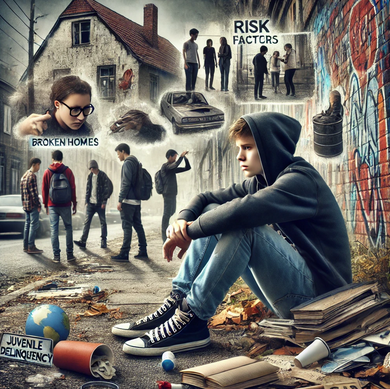Although some individuals may be born with a predisposition to violence or criminal behavior, the general consensus among forensic psychologists is that in the majority of cases, beginning at birth, a child is exposed to various risk factors that contribute to the development of antisocial behaviors and juvenile offending. Juvenile delinquency will be explored in greater detail in terms of the reasons for antisocial behavior and any measures that can be taken to prevent an offending trajectory; beginning with the relevant statistics pertaining to juvenile criminal activity, and the various well-known psychological theories on the causes of juvenile delinquency, including: the theories of judgment and decision making, along with the social neurocognitive developmental approach. We will explore the various risk factors of juvenile offending and recidivism. Recent research findings will also be mentioned as they relate to the discussion of the topic. A brief discussion on adolescents’ abilities to make informed decisions regarding their rights and their criminal cases will also be included.
In 2010, 4% of individuals 18 and below were arrested in the United States, which equates to over 1.3 million criminal cases that were processed in juvenile courts; cases consisted of 37% property offenses, 25% persons offenses, 12% drug offenses, and the remainder various types of public order arrests. The number of juveniles incarcerated in all U.S. adult prisons or jails declined from a peak of 10,420 in 2008 to a low of 2,250 in 2021, according to the Bureau of Justice Statistics. Half of these cases involved individuals under the age of 16. Although roughly two-thirds of juvenile cases involved adolescent Caucasians, African American and American Indian youth had higher rates of arrest per 1,000: 87.6 per 1,000 African Americans under the age of 18 were involved in criminal cases, 36.6 per 1,000 American Indian, and 36.4 per 1,000 Caucasian. It is also worth mentioning that men are more likely to commit crimes, especially violent crimes.
Juvenile delinquency is a global concern, although the rates of delinquency vary depending on the culture. In China for example, only 1% of individuals below the age of 20 were arrested for a criminal offense in 2010, the majority of which were nonviolent crimes. Along with cultural differences, researchers hypothesize that personality traits of individuals differ between Asian cultures and that of the United States and European Nations. Although the various risk factors are thought to be applicable across cultures, differences in personality influence how these life events are interpreted and to what extent they may negatively affect normative adolescent development.
Judgment Theory
Judgment theory identifies three developmental factors that explain why, when compared to adults, adolescents tend to make poorer choices: risk perception and preference, peer influence, and temporal perspective. According to judgment theory, adolescents are more sensitive to reward, and less sensitive to the idea of potential punishment or harm. As an individual develops and becomes a young adult, the idea of potential harm or future loss begins to play a larger role in the decision making process. Throughout adolescence, the way peers perceive an individual becomes increasingly important, placing the individual at a higher risk of being negatively influenced compared to adult counterparts. Furthermore, adolescents are more likely to identify the short-term benefits, instead of the potential long-term consequences; even when the long-term implications are identified, an adolescent has less capacity to appropriately weigh the short and long-term consequences. Deficits caused by these three developmental factors slowly begin to taper off as the individual reaches adulthood. This may help explain why crime tends to rise in early adolescence, with a peak in late adolescence, and begins slowly fading in young adulthood.
The executive function, defined as a group of “…deliberate, top-down neurocognitive processes involved in the conscious, goal-directed control of thought, action, and emotion” is not fully developed until early adulthood, and is responsible for controlling processes involved in planning, self-regulating, goal selection, and attention. The dual systems model builds on the theories stated above, and proposes that the two main neurocognitive brain systems, located in the prefrontal cortex and throughout the limbic system, develop on different timetables; this suggests that the adolescent brain actually predisposes the individual to certain behaviors if a heightened affective response is involved.
The prefrontal cortex, which is slower to develop, plays a significant role in decision-making, future planning, working memory, and response inhibition, which is the ability to consciously suppress a behavior or response that is primed to occur based off past experience, in certain situations. The limbic system, also referred to as the socio-emotional system, is active during various tasks involving risk, reward, and motivation; it is also responsible for regulating emotional responses during times of stress in which the ability to effectively reason is required. The continued research on the differences in the juvenile brain has gained credibility in the legal system and has been acknowledged in many recent legal decisions.
Risk Factors
In the field of forensic psychological research, not only is importance given to the neurophysiological, cognitive, and psychosocial components of juvenile delinquency that were discussed above, but interest is also given to the various ecological and individual, risk and protective factors of juvenile offending. Risk factors are often used to assess the probability of an individual becoming delinquent, and the chances for repeat offending.
Risk factors generally include any individual or environmental factors that increase the likelihood of negative behaviors or juvenile offending. Protective factors are thought to decrease the likelihood of negative behavior, or mitigate the negative effect of certain risk factors. Some factors are considered to be static, which are unable to be changed, such as the increased risk of criminal behavior in the male gender; others are dynamic factors, which can potentially be changed, such as inadequate parenting or discipline. The number of factors, and the length of exposure to them, determines the severity of the impact on the child’s behavior.
Individual Factors
Individual factors are often thought to be the most influential during early years, and include the individual’s temperament. Low intelligence, and the existence of any childhood neurodevelopmental disorders are also examples of individual risk factors. Roughly 5-10% of the population is affected by one of these disorders, which include attention deficit hyperactivity disorder and various tic disorders. In one study, children diagnosed with ADHD or tic disorders were at a substantially high risk for violent behavior later in life, which was defined in the study as: homicide, assault, robbery, arson, any sexual offense, illegal threats, and intimidation.
Individuals with psychiatric conditions such as depression or post-traumatic stress disorder are found to be at higher risk of offending. In one study, a correlation was found between low levels of physiological arousal, measured with a skin conductance response test, and antisocial behavior. The same study also suggested that low heart rate in response to a stressful situation indicates the lack of a normal fear response, which is thought to reduce the likelihood of feeling guilt or shame. Most individual factors are considered static, biologically predetermined traits that are unlikely to be changed with environmental influence.
Environmental Factors
Environmental factors, which include both static and dynamic factors, are also believed to play a significant role in the proper development of a child. It was found that low-income children had a significantly higher risk of antisocial behavior before the age of 5, leading to criminal behavior in adolescence in mixed neighborhoods, compared to those living in concentrated poverty. Non-poor children are also associated with higher levels of antisocial behavior when living in mixed neighborhoods, compared to children surrounded by equally affluent families. Although these individuals are at higher risk of becoming delinquent, the majority of children living in poverty or mixed neighborhoods do not grow to become juvenile offenders; this is referred to as resiliency, a term used to describe an individual’s ability to grow into an adult who lives a socially acceptable lifestyle, despite the exposure to any negative risk factors.
Family Factors
Family factors can include parenting practices, divorce, and family size. It has been found that the families of children with conduct problems are eight times more likely to be involved in disciplinary conflict, and are half as likely to engage in positive interactions with parents and other family members. Poor communication, supervision, and disciplinary practices, increases the risk of antisocial behavior in adolescence. Physical and verbal parental abuse place a child at increased risk for becoming violent offenders before reaching the age of 18. One study claims that 20% of children that are abused become delinquent in adolescence. Although divorce has been correlated with noncompliance and antisocial behaviors, it is still unclear how much of an effect divorce has on a child when factoring in other co-occurring risks. Family size, even when other factors are considered, has been associated with juvenile delinquency. Regardless of socioeconomic status, boys who have four or more siblings before the age of ten are twice as likely to offend compared to those with less siblings.
Peer Influences
While individual and family risk factors play a larger role early in life, negative peer influences usually begin to play an increasingly larger role in early adolescence. A relationship between delinquent peer influence and juvenile offending is generally well established throughout the field of forensic psychology; what is unclear though is whether or not this association with delinquent peers is a result of antisocial tendencies developed earlier in life, or if it actually contributes to the overall risk of developing delinquent behavior. It has been suggested that deviant peer groups do in fact influence non-delinquent individuals to become delinquent. According to the National Youth Survey of juveniles ages eleven to seventeen, a common pattern that was seen was a child switching from a non-delinquent peer group to a deviant peer group, resulting in the commission of various minor offenses, and in some cases more severe crimes. Gang membership is also strongly correlated with self-reported criminal activity. It is suggested that the association of peer groups with antisocial tendencies leads to a greater suspiciousness of other people’s motives, resulting in further hostile and aggressive responses to those outside of the group.
Drugs and Alcohol
Exposure to drugs and alcohol, specifically prescription drugs, during adolescence was predictive of various violent criminal offenses, including: attacking another person with a weapon, throwing potentially dangerous objects at another person, and forcibly taking money from another individual. Ongoing substance use disorders are linked to an increased risk of arrest, as well as continued offending throughout adolescence and early adulthood. Higher sensitivity to reward in the juvenile brain increases the risk of becoming dependent on an illicit substance.
If a minor is arrested and charged, are they competent to make legal decisions regarding their case? In Dusky v. United States, it was established that the defendant must have a basic understanding of the legal process and what is happening to them, in order to effectively make decisions, which potentially have life-altering consequences; they must also appreciate the importance of their own unique situation. It has been found that juveniles under the age of 15, and those individuals with low IQs do not understand the rights that are given to them by Miranda; resulting in an increased risk for falsely confessing to a crime. It has been suggested that adolescents facing criminal charges are limited in their abilities to “identify, consider, and foresee the options and consequences of decisions that face defendants in these circumstances.” Decisions made by an adolescent are constricted by the cognitive abilities of the developing adolescent brain; if asked to make the same decision as an adult, the result may be a completely different response.
Juvenile delinquency is a broad topic in the field of forensic psychology, and a global problem. With help from the various psychological theories discussed above, including the physiological theories of delinquency exploring the biological predisposition for adolescents to make bad decisions, the purpose of this paper was to emphasize the fact that special consideration should be taken into account when it comes to punishing a juvenile offender. Researchers are becoming increasingly knowledgeable regarding the various risk factors that contribute to delinquency. Although some risk factors mentioned above are static and unchangeable, such as gender or low IQ, others are dynamic and changeable; for example, parental practices of promoting a positive self-image or rewarding empathic behaviors. More research needs to be done in the identification of risk factors, and how to use that knowledge to implement preventative measures. The government should not only try and predict future juvenile criminal behavior and recidivism, but should also help find ways to prevent it from occurring. Although forensic psychologists and other educated individuals may understand the limitations of the adolescent brain in the context of making important legal decisions, the general public may not; it is important to emphasize these limitations and educate those in positions of power within the juvenile court system.
Fort Lauderdale’s Leading Criminal Defense Attorney
If you have been charged or believe you may be charged with a juvenile offense or any other criminal act , an experienced criminal defense attorney is imperative. Kenneth Padowitz, P.A. aggressively handles all State and Federal criminal charges. Contact our law firm to discuss your situation. Our Fort Lauderdale criminal attorney will strategically develop a defense designed personally for you and your situation. Kenneth Padowitz, P.A. represents clients throughout Broward County and all of South Florida, including: Fort Lauderdale, Miami, Palm Beach, Boca Raton, Weston, Hollywood, Davie, Parkland, Cooper City, and Coral Springs.
References
- Cornet, L., Kogel, C., Nijman, H., Raine, A. & Laan, P. (2014). Neurobiolgical Factors as Predictors of Cognitive-Behavioral Therapy Outcome in Individuals With Antisocial Behavior: A Review of the Literature. International Journal of Offender Therapy and Comparative Criminology, 58(11), 1279-1296. doi: 10.1177/0306624X13494694
- Cuervo, K. & Villanueva, L. (2014). Analysis of Risk and Protective Factors for Recidivism in Spanish Youth Offenders. International Journal of Offender Therapy and Comparative Criminology, 2014, 1-17. doi: 10.1177/0306624X14557917
- DeLesi, M., Angton, A., Behnken, M. & Kusow, A. (2013). Do Adolescent Drug Users Fare the Worst? Onset Type, Juvenile Delinquency, and Criminal Careers. International Journal of Offender Therapy and Comparative Criminology, 59(2), 180-195. doi: 10.1177/0306624X13505426
- Drazdowski, T., Jaggi, L., Law, M., Borre, A. & Kliewer, W. (2015). Use of prescription drugs and future delinquency among adolescent offenders. Journal of Substance Abuse Treatment, 48(2015), 28-36. doi: http://dx.doi.org/10.1016/j.jsat.2014.07.008
- Dusky v. United States (1960). No. 504, 362 U.S. 402
- Graham v. Florida (2010), No. 08-7412, 130 S.Ct. 2010
- Lundstrom, S., Forsman, M., Larsson, H., Kerekes, N., Serlachius, E., Langstrom, N. & Lichtenstein, P. (2014). Childhood Neurodevelopmental Disorders and Violent Criminality: A Sibling Control Study. J Autism Dev Disord, 44(2014), 2707-2716. doi: 10.1007/s10803-013-1873-0
- Odgers, C., Donley, S., Caspi, A., Bates, C. & Moffitt, T. (2014). Living alongside more affluent neighbors predicts greater involvement in antisocial behavior among low-income boys. Journal of Child Psychology and Psychiatry, 2014, 1-11. doi: 10.1111/jcpp.12380
- Palermo, G. (2009). Delinquency: Risks and Protective Factors. International Journal of Offender Therapy and Comparative Criminology, 53(3), 247-248. doi: 10.1177/0306624X09335886
- Palermo, G. (2015). Transculturalism and Risk Factors for Violent Behavior. International Journal of Offender Therapy and Comparative Criminology, 59(1), 3-4. doi: 10.1177/0306624X14558904
- Piquero, A., Jennings, W., Diamond, B. & Reingle, J. (2013). A Systematic Review of Age, Sex, Ethnicity, and Race as Predictors of Violent Recidivism. International Journal of Offender Therapy and Comparative Criminology, 59(1), 5-26. doi: 10.1177/0306624X13514733
- Tong, T., Ku, L. & Zaroff, C. (2014). The Influence of Culture-Specific Personality Traits on the Development of Delinquency in At-Risk Youth. International Journal of Offender Therapy and Comparative Criminology, 2014, 1-20. doi: 10.1177/0306624X14556609
- Wasserman, G., Keenan, K., Tremblay, R., Cole, J., Herrenkohl, T., Loeber, R. & Petechuk, D. (2003). Risk and Protective Factors of Child Delinquency. Child Delinquency Bulletin Series, (Apr. 2003), 1-10.
- Woolard, J., Vidal, S. & Fountain, E. (2015) Juvenile Offenders. In B.L. Cutler & P.A. Zapf (Ed.) APA Handbook of Forensic Psychology (pp. 33-52). United States. American Psychological Association. doi: http://dx.doi.org/10.1037/14462-002








